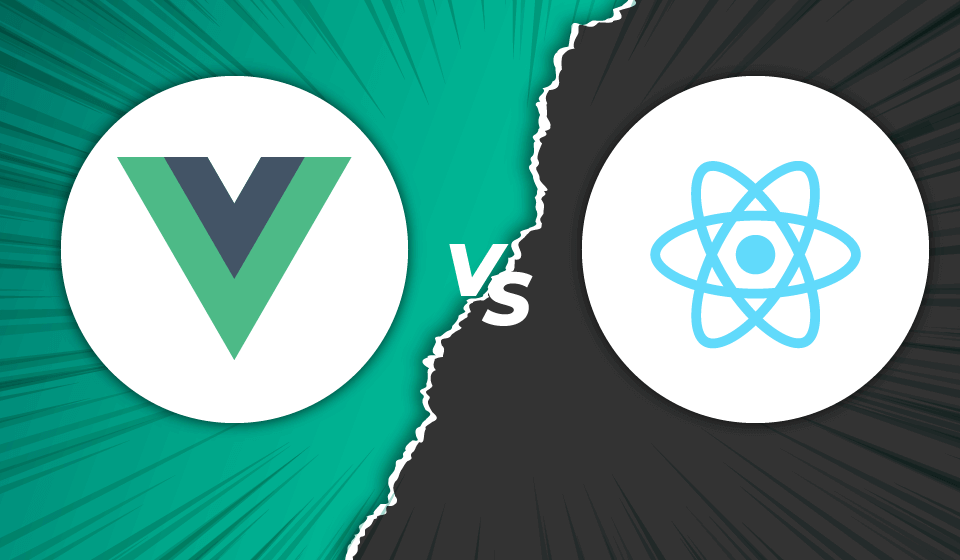The popularity of front-end frameworks keeps on increasing every year. And you can’t imagine their development without using JavaScript. There was a tough competition between two players for years: Google’s Angular and Facebook(now Meta)’s React. But, 2018 got one more player in the round – Vue. So let’s discuss the differences between Vue vs React.
Currently, React and Vue are the most discussed frameworks in the JavaScript world. They are well advanced and have significant pros & cons. Both are equally unique in their ways. So, let’s first understand what these technologies are and which framework should you choose for your project?
What is React/ReactJs?
React is an open-source front-end javascript library used for building software that continuously refreshes data on its user interface. Since it is based on javascript, ReactJs can be effectively used to create applications and interfaces that are highly interactive.
Advantages of React
Below are some of the benefits of React:
- It provides you with maximum flexibility and responsiveness.
- It has a rich JavaScript library as various contributors worldwide put continuous efforts to add more features.
- React uses virtual DOM. It allows you a browser-friendly arrangement of documents in HTML, XHTML, or XML format.
- The flexible structure and scalability of React make it a better option for large-scale apps.
- React provides you with the React Native platform. It lets you develop native-rendered apps for iOS and Android through the same React component model.
- It has the backing of professional developers from Facebook, and they continuously look for ways to improve it.
- ReactJs applications can also be easily inspected by React developer tools which makes them more bug-proof.
Disadvantages of React
Below are some of the cons of using React:
- React has a complex setup process, properties, functions, and structure. Hence, it requires deep knowledge to build an application.
- The high pace of development makes it difficult for developers to adapt to changes with constant environment updates.
What is Vue?
Vue is an advanced Javascript framework to build single-page applications and user interfaces that uses model-view-view-model (MVVM) architectural pattern. The MVVM architecture provides an intuitive interface for front-end and back-end developers. VueJs has a unique feature known as directives that are HTML features that allow developers to enhance/expand HTML.
Advantages of Vue
Here are some of the benefits of using Vue:
- Vue embraces standard HTML-based templates. Hence, making it easier to use and revamp an existing application.
- Vue consumes less space. Therefore, it gives better performance than other frameworks.
- Vue offers smoother integration of smaller parts without any effect on the whole system. It doesn’t matter whether it’s a single-page application or a complex web interface.
- Vue provides hassle-free migration, a simple and efficient structure, plus reusable templates. Its overall sound design and architecture make it a popular JavaScript framework.
- Vue provides you with an easy learning curve through proper documentation with no extra knowledge required. HTML and JavaScript will do your job.
Disadvantages of Vue
Below are some of the cons of using Vue:
- Vue framework still has a very small market share as compared to Angular and React.
- Despite Vue becoming popular faster, one can have issues in terms of large-scale app development.
Are you looking to Hire VueJS Developers for your project? Then, we have a team of highly-qualified and experienced developers in the field.
React vs Vue – Which one is better?
Now, we will find out the difference between Vue vs React. Here are they-
1. Popularity and Support
A library’s popularity may affect the number of developers ready to hire and the quality of third-party libraries. That means someone has already solved the problems that you may encounter while developing your project.
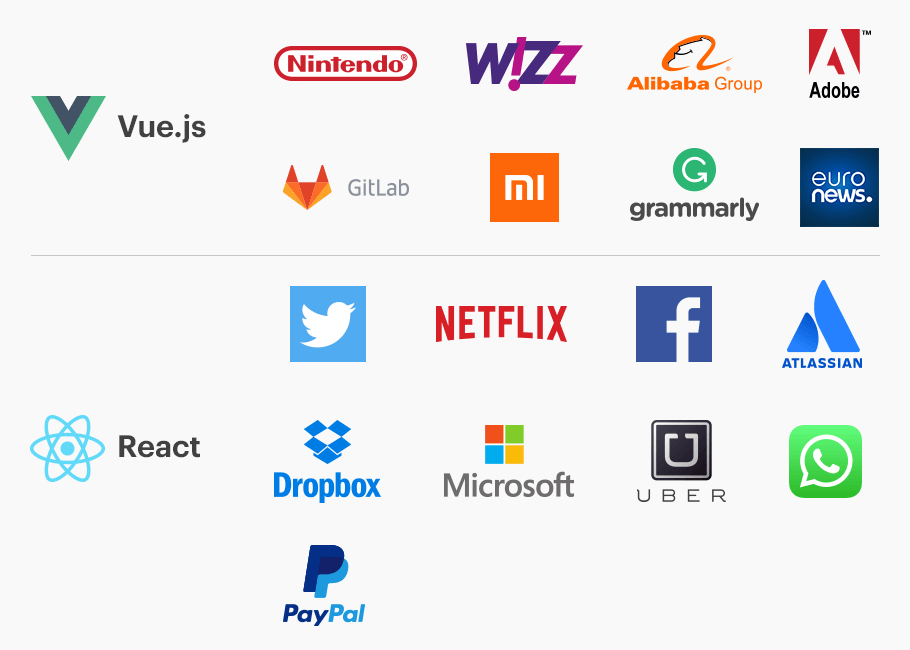
React has huge community support with third-party libraries, packages, tools, and extensions. It has great support from all major IDEs. React translates more tutorials, online courses, articles, and 3+ times more questions on Stackoverflow.
Facebook has developed and is maintaining the library, guaranteeing long-term support. Multiple FB projects use them, and each team can update the library. There is no official roadmap as updates depend upon requests for comments. But, React’s community is more fragmented than Vue’s, spending more time searching for solutions to common issues.
On the other hand, Vue may have a smaller market share, but its community is constantly evolving. It has fewer resources, packages, and third-party libraries as compared to React. More of its tools are available right out of the box. Vue has support from all major IDEs but is not as extensive as React.
Evan You, along with 24 developers, maintains it, financed via crowdfunding. You can watch its high-level roadmap on GitHub.
2. Talent Availability
As React is the most popular front-end library, there are more experienced engineers available for hire. According to 2021’s front-end tools survey report, more than 52% of developers can easily use React (vs 23% of Vue).
HackerRank’s Developer Skills report mentions 33.2% of companies need React developers, but only 19% of engineers have the required skills. While for Vue, the shortage is even higher (10% vs 5.1%).
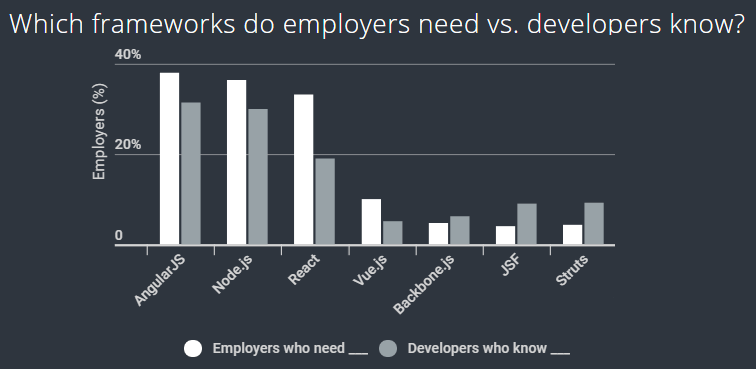
Although Vue gained traction just a few years ago, it comes fourth in the list of technologies that programmers would like to learn in 2022. Its incredible ease of learning would raise the number of Vue developers in the future.
3. HTML Templating vs JSX
One of the main differences between React and Vue is the way they handle templates.
React uses JSX. Here, both HTML and CSS are expressed via JavaScript with XML syntax. It enables you to build standalone GUI components containing all the rendering instructions. The declarative syntax lets you easily understand the function of a particular component.
JSX provides you the versatility of a full programming language with temporary variables, flow controls, and referencing JS values in scope. It also supports IDE features like autocomplete, type checking, and linting.
On the other hand, Vue follows a traditional approach. It uses Single File Components and distinct blocks for HTML templates, styles, and JS. It is familiar with any front-end developer to make the framework easy-to-learn.
Any valid HTML may be a Vue template. It allows you to migrate your project to Vue gradually. You can even add JS functionality with bindings and custom directives (attributes). The Framework provides you a great degree of customization that allows you to:
- Use SCSS or CSS scoping against CSS
- Drop your templates in favor of render functions or JSX; or
- Write your code in preprocessors like Pug
Hence, the choice between JSX and templates is a matter of personal preference. JSX is more powerful and flexible. On the other hand, templates offer a clear separation of concerns preventing you from injecting too much logic into views.
Also, designers and HTML developers are not used to JSX much. So, that makes collaboration a bit of a problem for UI/UX-heavy teams.
4. Documentation
React’s documentation looks pale as compared to Vue’s. It has the basics of React development, including some advanced concepts. Hence, making the presentation inaccessible or not so well-structured. Also, it doesn’t include a detailed overview of the React ecosystem, like in Vue’s docs.
On the other hand, Vue has amazing docs, and its API references are one of the best in the industry. It’s well-written, clear, and accessible, dealing with everything you need to know in creating Vue apps. You can translate the docs into several languages, as in React, in addition to English.
Hence, Vue has a little edge over React that has several issues for having a clear answer in the docs.
5. State Management
State means the data shared between all UI components. It’s harder to manage the data without unpleasant side effects as your system gets bigger.
State management is important for React apps. Some frameworks, like Redux, help you with massive states. They provide a single way to modify the state, making debugging simpler.
Vue doesn’t need a local state as you can modify data using the Vue object’s data property. However, for larger apps, you may need an external library for state management (e.g., Vuex).
It has a “single source of truth” like Redux, in the form of an application store. The only way you can alter the state is by using handler functions called mutations. However, the actions describing the state modifications are methods of committing mutations.
6. Performance
There are mainly two metrics that determine the speed of an app: start-up time and runtime performance. Both libraries have tiny bundle sizes to speed up the initial load. That is, 31KB for Vue/84.4KB uncompressed and 32.5/101.2KB for React and hence are equally efficient.
However, when comparing Vue.js vs react performance, Vue is a little better in memory allocation and startup times while React is a little faster at runtime. But, you should not judge a library’s performance just based on benchmarks. The speeds greatly vary depending on the app size and your optimization efforts
Both the libraries have:
- Server-Side Rendering (SSR);
- Tree shaking; and
- Bundling.
Plus, they use a virtual DOM. Modifying the real DOM is a resource-intensive task to apply the updates first to the virtual DOM.
In React, modifying a component state re-renders all its child components. You can use PureComponent, ComponentUpdate, or immutable data structures to improve performance. However, when the component’s props do not control child components’ render output, it can cause inconsistencies in the DOM state.
On the other hand, Vue tracks dependencies preventing unnecessary renders of child components.
On the other hand, Vue tracks dependencies preventing unnecessary renders of child components.
7. Ecosystem
Vue is a standalone framework while you have to use React together with other libraries. It’s one of the biggest differences between the two technologies.
React relies on external solutions such as Flux/Redux for routing and state management. It can simply debug by offering a single way to modify the state. Facebook has left managing React-redux and React-router to the community. Hence, resulting in a more fragmented ecosystem.
Vue has fewer companion libraries. The functionality that needs you to use the React library (e.g., props check) is already there in Vue. You do not need the local state to modify data using the data property of a Vue object.
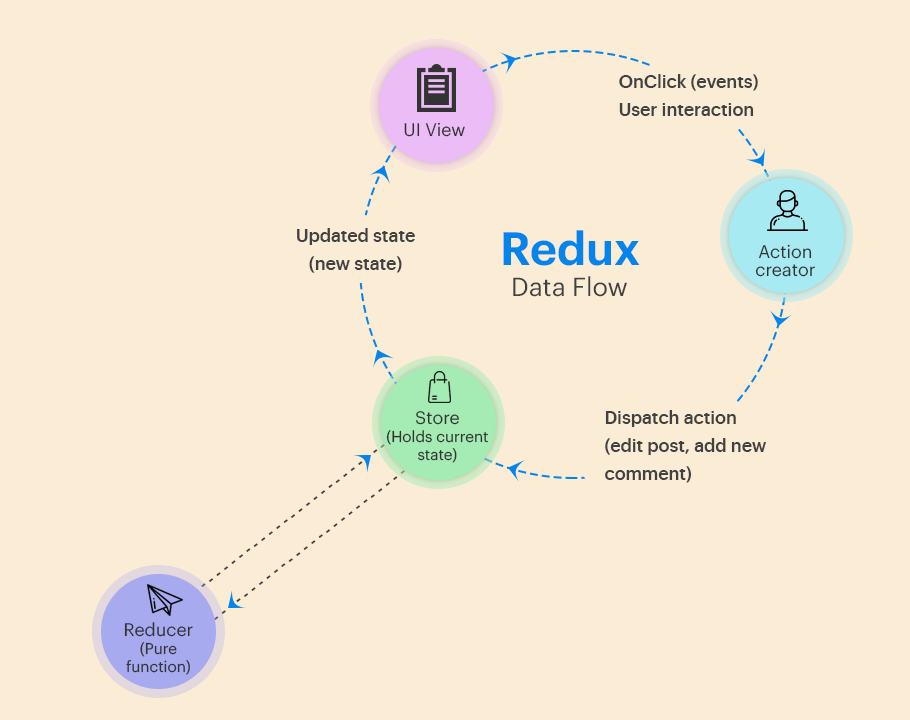
However, you will need an external library for state management for larger apps (e.g., Vuex). Just like Redux, it has one way to alter the state using handler functions called mutations. The Vue team maintains and supports the core frameworks like Vuex and Vue-router for routing.
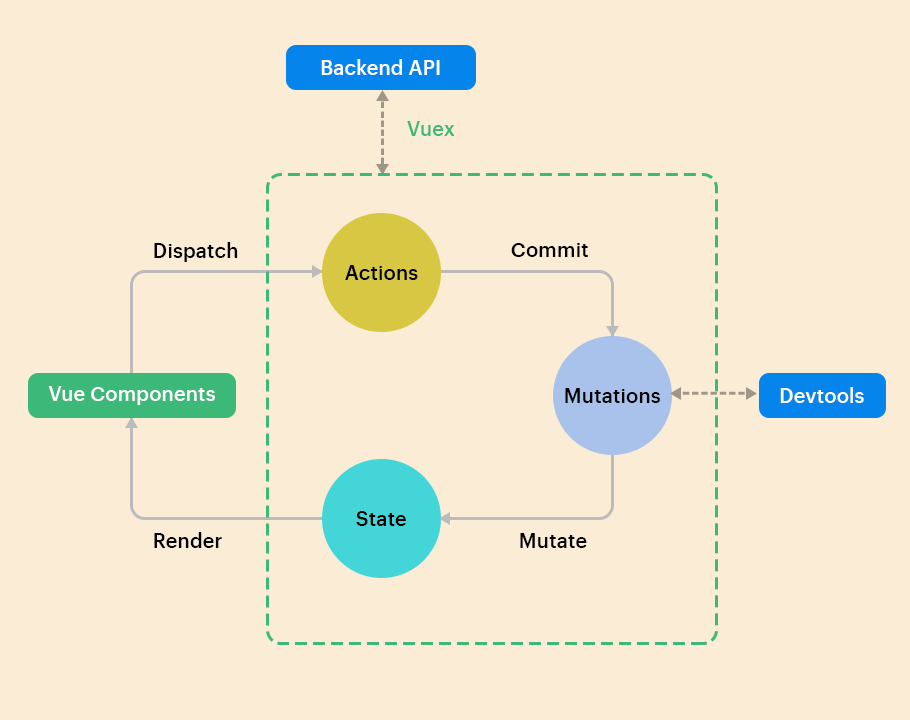
8. Scalability
When it comes to front-end frameworks, scalability comes in two ways. Expanding a single-page application (SPA) and adding more pages to traditional MPA.
React is lightweight so that you can use it in multi-page applications. Facebook does so on most of its pages. You can import the library and start to add JS features with React components. It‘s well-suited for large SPAs (just look at Facebook’s ad console).
While starting your project, you may need third-party form packages and routing solutions (e.g., Flux and Redux). You can use a scaffolding tool called create-react-app. It would help you build your project, set up a local development server, check code for errors, and run e2e/unit tests.
It’s a bit inferior to Vue CLI, as there is a little customization when creating a project. It just has one project template, an SPA. However, Vue CLI has a great range of templates for all occasions. Plus, there is no option to import your own or community-created templates.
On the other hand, Vue is excellent in creating interactive multi-page apps. It lets you quickly import the core library and inject Vue into existing pages. There is no need to use components for simpler features also.
Vue CLI helps you start building a new project in no time. It provides scaffolding, and you can use them with build systems like Webpack or Browserify (or no build system at all).
You have to install additional packages for routing and form validation. Flexibility increases in installing project dependencies as plugins down the road. You can simply update a plugin without bothering about changing or configuring the stacks even if some standards change.
So, Vue may be well-suited for developing large SPAs, but it wasn’t for the specified purpose. Reusing HTML templates is a pain as compared to JSX syntax as the project grows.
9. Server-side Rendering
Google can easily crawl JavaScript content. So, server-side rendering isn’t as important for SEO as before.
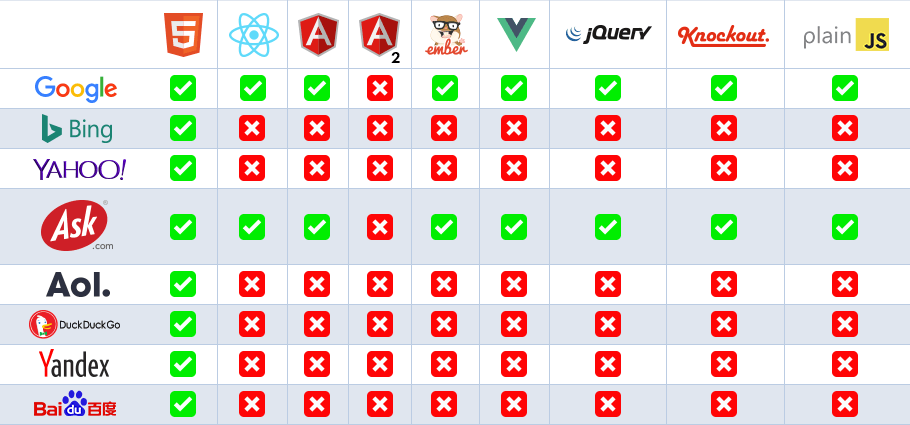
SSR is great for user experience also. It helps you quickly load an interactive template and populate it with content later on. Its absence would make the users stare at an empty page while the device loads and renders the content. Plus, social networks do not properly display content shared from client-rendered sites.
Vue has the edge over React with its in-built SSR capabilities and a detailed guide in the documentation. React needs third-party libraries like Next.js to render pages on the server, though.
10. Mobile
React Native is unarguably the king of cross-platform development. It lets you reuse up to 99% of JS code between iOS and Android with React-like components.
You can build 100% native widgets that control your style. It handles the view layer as a pure state output. Hence, making it easy to create companion apps for Android/ios with a native look and performance.
Vue may lag behind React, but it offers various solutions for mobile development. Firstly, you have NativeScript allowing you to write Vue applications and compile them to native Android/iOS apps.
Alibaba’s Weex platform is another option. Its component-based architecture helps you write code, and you can easily render it on the web, iOS, and Android.
However, most of its community comes from China. So, you can finally use Quasar to build hybrid mobile apps.
React vs Vue: Comparison
| Parameters | React | Vue |
| Type | JavaScript Library | JavaScript Library |
| Ideal for | Web and Native both | Primarily for Web development, but later on, it was written to support other platforms too |
| Developer(s) | Facebook community (developed by Jordan Walke) | Evan You |
| Initial Release | March 2013 | February 2014 |
| Written in | JavaScript | JavaScript |
| Cross-platform development | React’s React Native is a widely used and mature platform for native-rendered apps | Vue’s Weex is evolving and aims at providing a smooth development experience |
| Learning Curve | Steep learning that requires deep knowledge | The easy learning curve as HTML-based templates make it familiar |
| Popularity | Ranks second among the hottest JavaScript projects on GitHub | Ranked first as the trendiest project in 2017 with more than 40,000 stars added on GitHub during the year |
| Reusability | Only CSS | Maximum reusability |
| Contributors on GitHub | 1201 | 189 |
| Performance | Similarly fast | Similarly fast |
| Functions | Used as a base in single-page or mobile app development | Web application framework can empower advanced single-page applications |
| Model | Virtual DOM | Virtual DOM HTML-based templates |
| Bootstrap Application | CRA (Create React App) | Vue CLI |
| Notable Features | One-way data binding with propsVirtual DOMStateful componentsLifecycle methodsJSX (JavaScript XML)Architecture beyond HTML | HTML-based templateReactivityComponents (dividing the whole app into small, self-contained and frequently reusable components)RoutingTransitionsIntegrations |
| Simplicity | More complex than Vue | Simpler than React |
Conclusion – ReactJS and VueJs
Vuejs vs react both are excellent choices for a modern web application.
React is a battle-tested leader with support from corporations with a huge open-source community. Its library scales better and allows you to create complex enterprise-grade applications.
There is no shortage of qualified React developers due to its huge ecosystem. So, you can easily find a solution to almost any problem you might encounter on the project. Plus, React Native is the best cross-platform solution in the market.
Vue is the rising star in front-end development. It’s very easy to learn and love to work with. The framework’s more traditional syntax allows you to migrate existing projects to Vue. Plus, it has the best-in-class documentation, and its performance is even better than React.
Vue provides you with more tools out of the box with the core team’s support. Vue CLI 4 helps you quickly set up a project and deliver a market-ready solution within weeks.
But as with most technologies, the choice often comes down to your personal preference. The following points will help you choose a better way.
| Choose Vue if | Choose React if |
| You want a working solution as soon as possible (e.g., startups). | You want to create a complex enterprise-grade solution/SPA. |
| You want to migrate an existing project to new technology over a period of time with limited resources. | You want to create a mobile app. |
| Your app is pretty simple and would want to make it lightning fast. | You want to expand your app’s functionality in the future and need continuous support. |
| Your developers prefer clean code and HTML templates. | Your developers prefer JavaScript over HTML. |
| Your team mainly consists of HTML/ junior developers to save money. | You have an experienced React developers’ team. |
Hope, now your dilemma regarding choosing the right technology must have solved.


